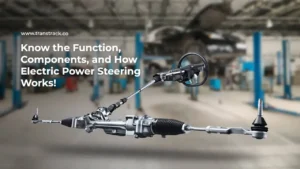Troubleshooting a Fuel Pump Malfunctions and Its Causes!
Posted on July 29, 2024 by Nur Wachda Mihmidati

The fuel pump is an important component in a vehicle’s fuel system, responsible for pumping fuel from the tank to the engine. When the fuel pump malfunctions, a variety of serious problems can arise, ranging from difficulty starting the engine to sudden vehicle stalling while driving. Understanding the symptoms and causes of fuel pump damage is essential so that you can take the right steps to repair it and prevent further problems. This TransTRACK article will discuss the common symptoms of fuel pump damage, the underlying causes, and the repair steps you can take to maintain optimal vehicle performance.
What are the symptoms of a faulty fuel pump?
Symptoms of a faulty fuel pump include:
Engine Difficulty Starting
Difficulty starting the engine can be an early sign of a faulty fuel pump because not enough fuel is being pumped to the engine. This often happens especially when you first start the vehicle in the morning.
The Car Suddenly Stops While Driving
If the car suddenly shuts off while driving, it is likely that the fuel pump is unable to deliver fuel consistently to the engine. This condition can be very dangerous, especially if it happens at high speed or on the highway.
Decreased Engine Performance
A damaged fuel pump can cause the engine to lose power, making acceleration slow and the vehicle difficult to reach high speeds. This decrease in performance is usually most noticeable when the car is carrying heavy loads or going uphill.
Buzzing Sound from the Fuel Tank Area
A buzzing or noisy sound from the fuel tank area can be a sign that the fuel pump is experiencing wear or damage. This sound is often heard when the engine is running or after the car is started.
Buzzing sound from the fuel tank area.
A buzzing or noisy sound from the fuel tank area can be an indication that the fuel pump is experiencing wear and tear or internal problems. This sound is usually heard when the engine is running or shortly after the car is started, and can get louder over time.
What causes a faulty fuel pump?
There are several causes of a faulty fuel pump including:
Dirty Fuel
Particles and impurities in the fuel can clog and damage the internal components of the fuel pump, causing faster wear. They can also block the flow of fuel that the engine needs.
Clogged Fuel Filter
A clogged filter blocks the flow of fuel, making the fuel pump work harder to deliver fuel to the engine. As a result, the fuel pump can quickly heat up and become damaged.
Overheating of the Fuel Pump
High temperatures can damage the electric motor inside the fuel pump, especially if the car is often run with a nearly empty fuel tank. An overheated fuel pump can fail and stop functioning.
Use of Low Quality Fuel
Low-octane fuels or those containing many additives and contaminants can reduce the efficiency and life of the fuel pump. These low-quality fuels can cause residue formation that damages the internal components of the fuel pump.
How to repair a faulty fuel pump?
How to repair a faulty fuel pump includes:
Checking and Cleaning the Fuel Filter
The fuel filter should be checked regularly to ensure that there are no blockages or debris blocking the flow of fuel. This process involves removing the filter from the fuel system and checking for deposits or debris that could interfere with the fuel pump’s performance. If the filter looks dirty, it can be cleaned with a special cleaning fluid or compressed air. However, if the filter is very dirty or clogged, replacing it with a new one is the best solution to ensure optimal fuel flow and prevent further damage to the fuel pump.
Replacing the Fuel Pump with a New One if the Damage is Severe
Fuel pumps that are severely damaged usually show symptoms such as noise, unstable fuel pressure, or no function at all. Diagnosing this damage can be done with a fuel pressure gauge to confirm that the fuel pump is unable to maintain the required pressure. If the damage is severe, replacing the fuel pump is the best solution. The replacement process involves emptying the fuel tank, removing the old fuel pump, and installing the new one, which requires specialized equipment and good mechanical skills. Therefore, it is often better to have this process done by a professional at a repair shop to ensure proper and safe installation.
Checking and Replacing the Associated Relay or Fuse
Relays and fuses are important electrical components that control fuel pump operation. If the relay or fuse is damaged, the fuel pump will not receive the electrical power needed to operate, so the vehicle cannot run properly. A check of these components can be done with a multimeter to ascertain if they are still functioning properly. If relays or fuses are found to be faulty, they should be replaced with components that match the vehicle’s specifications. In addition, it is important to inspect and clean the connectors and connected wires to ensure there is no corrosion or other damage that could affect the fuel pump’s performance.
Troubleshooting a faulty fuel pump is not only important to maintain vehicle performance, but also to ensure safety and efficiency on the road. By understanding the symptoms, causes, and how to fix a problematic fuel pump, you can take proper preventive and corrective measures. However, manually managing vehicle maintenance can be a confusing and time-consuming task.
For a more effective and efficient solution, use TransTRACK’s Vehicle Maintenance System. This system is designed to help you monitor and manage vehicle maintenance automatically and in real-time. With advanced features such as component condition monitoring, maintenance reminders, and diagnostic reports, TransTRACK ensures that your vehicle is always in optimal condition. Don’t let fuel pump issues disrupt your operations – utilize TransTRACK’s Vehicle Maintenance System for smarter and more planned vehicle maintenance!
Recent Post
Know the Function, Components, and How Electric Power Steering Works!
December 24, 2025Know the Types of Buses Based on Their Model, Size, and Capacity!
December 22, 2025Topic :
Recommended Articles

 Bahasa Indonesia
Bahasa Indonesia








